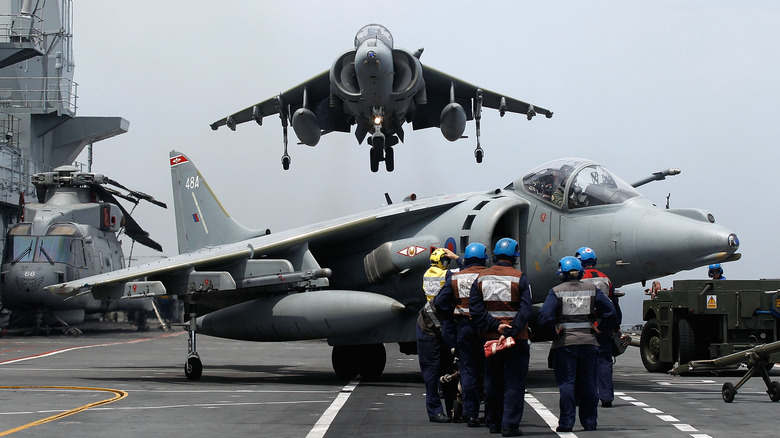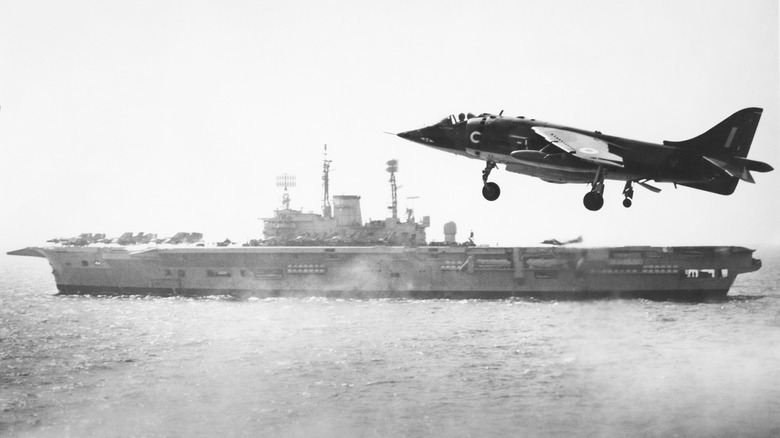Why The Legendary Harrier II Jet Was Retired By The RAF
The Harrier's slick-sounding name is iconic even to those with just a passing familiarity with combat aircraft. It was the first operational VTOL jet aircraft, using a horizontally mounted turbofan engine wherein the thrust could be redirected by tilting its exhaust ports towards the ground, achieving proper vertical takeoff.
The difficulties in creating a fighter that was so different from other jets in that it could take off and land on a dime (like a helicopter) were monumental and took several years to achieve. Interestingly, the first designs for a vertical takeoff craft were patented by none other than Nikola Tesla way back in 1928.
In 1957, Hawker Aviation's Sir Sydney Camm and Ralph Hooper teamed up with Sir Stanley Hooker at the Bristol Engine Company (BEC). They began work on what would eventually become the Hawker Siddeley Harrier. The initial idea was to combine two of BEC's existing engines — the Olympus and Orpheus — to create a turbofan engine with directable thrust, but wanting to meet the requirements for NATO's Light Tactical Support Fighter, decided to base it on their existing Pegasus engine instead.
After several prototypes (the P.1127 and the Kestrel FGA.1) were tested, tweaked, and upgraded, the first production Harrier (GR.1) flew on December 28, 1967. The first Harriers roared into the U.K.'s Royal Air Force service on April 1, 1969. Several iterations followed, including the Sea Harrier, used extensively in 1982 during the Falklands War.
Budget cuts doomed the jump jet
The incredible capabilities of the Harrier jump jet kept it part and parcel of the Royal Air Force for more than five decades. Then, on October 19, 2010, Prime Minister David Cameron announced that as part of the Ministry of Defence's Strategic Defence and Security Review (SDSR), the entire Harrier Force would be cut and wholly removed from service by March 2011.
The SDSR occurs roughly every five years and is a transparent, in-depth appraisal of Britain's national security and defense needs. Paradoxically, that announcement occurred almost 50 years to the very day the Harrier's first prototype (the P.1127) — piloted by Bill Bedford — made its inaugural test flight on October 21, 1960.
The 2010 SDSR came at the wrong time, as the U.K. was coming out of the 2007–08 economic crisis, which led politicians to look very carefully at defense spending. In the months leading up to the surprise announcement, the U.K. was alight with rumors about what would get the axe.
The RAF was flush with five squadrons of Tornado GR4s at the time but had only two of the Harriers. The Tornado was used far more extensively in Afghanistan than the Harriers, but because there were more of them, it seemed plausible they would get cut. Knocking on the door was the newest fighter in the bunch, the Eurofighter Typhoon FGR4s, but it didn't pack the same ground attack punch as the Tornado, so cutting it would have been a significant loss of offensive firepower.
The Harrier flew off into history
The day before the official announcement in October 2010, senior commanders of the Harrier Force gathered at RAF High Wycombe, where Air Chief Marshal Sir Stephen Dalton informed them that they were being deactivated, along with others (including the entire Nimrod MR2 maritime patrol fleet), and were given orders to cease operations by the end of that same year.
That night, the news broke, and reports leaked that planes weren't the only things in the crosshairs, as Royal Navy aircraft carriers (such as the HMS Ark Royal, Ocean, and Illustrious) were also being considered. It's hard for those in the United States to comprehend the Harrier's importance to those in the U.K. Air Vice Marshal Gary Waterfall felt his duty was to take care of "a nation's icon" and lay "her to rest with respect and dignity."
A goodbye event was put together by Waterfall that would have included a 16-ship flyover formation of Harriers on December 15, 2010, but poor weather precluded them from safely executing it. Instead, they split into four groups of four planes for the final flight.
While the Royal Navy wanted to keep 20 or so of the jump jets, that never came to fruition. The U.S. Marine Corps eventually purchased the entire fleet of 74 Harriers from the RAF for $177 million to be used as spare parts for its own fleet.

